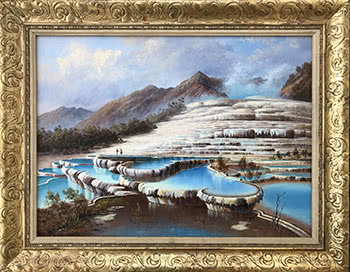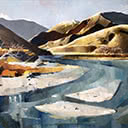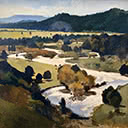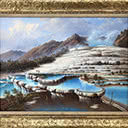The White Terraces with Two Figures
41 x 56.5 cm
est. $30,000 - 40,000
PROVENANCE
Private Collection, Auckland
Fine New Zealand Paintings
& European Paintings Webb's, 30/08/1995 Collection of The New Zealand Embassy, Washington DC
Ex Collection of Ministry of External Relations and Trade - label affixed verso Deaccessioned, 1995 Charles Blomfield has long been recognised as the most popular early New Zealand painter of the Pink and White Terraces and the surrounding region of Rotorua and Lake Tarawera. Blomfield first visited the region during a camping trip in December 1875, commenting that Tarawera and it's Terraces were exceedingly beautiful and graceful.
Returning in 1883 he spent six weeks documenting the Pink and White Terraces and their surroundings. Blomfield's meticulous sketches and finished paintings are some of the most important historical records we have of the region. It was reported that by September 1885 orders for his work had been received from throughout Europe, America, Australia and other places.
Following the Tarawera eruption, Blomfield realised that the paintings he had made of the Terraces were a valuable record, and declined to sell them. He went on to paint and sell scale copies of these works, for which the prices soon trebled.
The story of the Tarawera eruption is a dramatic chapter in New Zealand's history. Eleven days before the eruption, both Maori and European visitors, including the famous Guide Sophia, reported seeing a ghostly Maori war canoe paddling across Lake Tarawera. Guide Sophia consulted her tribe's tohunga, or priest, Tūhoto Ariki, and he interpreted the phantom canoe as a bad omen. He believed Maori would be punished for exploiting the area for money without paying due respect to their ancestors.
In the early hours of 10 June, 1886 Tūhoto Ariki's prophecy was fulfilled. At Te Wairoa village, people were woken after midnight by a series of strong earthquakes. Around 2 am Tarawera erupted with fountains of glowing lava and a cloud of ash up to ten kilometres high, through which intense lightning flickered. At Te Wairoa, more than sixty people sheltered in Guide Sophia's sturdy hut, which remarkably survived the eruption.
Later, craters on the south-west side of the mountain blasted open and a crack 17 kilometres long emitted tons of mud and ash. The Tikitapu bush was completely covered by ash and earthquakes were felt throughout the North Island with the noise of the eruption heard as far south as Blenheim. At the time, many Aucklanders thought they were hearing distant cannon fire. Blomfield decided to see the devastation for himself and returned to the area in October to paint several scenes of the terrible destruction.
A world away, fourteen Charles Blomfield paintings were being greatly admired in South Kensington, London at the 1886 Colonial and Indian Exhibition. This major exhibition, which in the words of the Prince of Wales was intended to: stimulate commerce and strengthen the bonds of the British Empire was opened by Queen Victoria and received over five million visitors. Charles Blomfield died at his residence in Wood Street, Freemans Bay, Auckland in 1926.
The White Terraces were at the north end of Lake Rotomahana and faced away from the lake at the entrance to the Kaiwaka Stream. They descended to the lake edge forty metres below. The additional sunlight received from facing north created their bleached white appearance. The White Terrace was the larger of the two formation, covering in excess of three hectares. They were reportedly the largest silica sinter deposits on earth.





